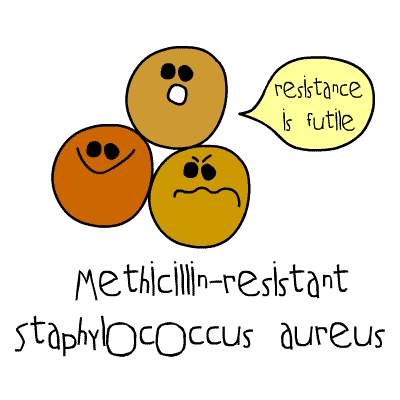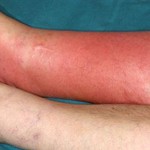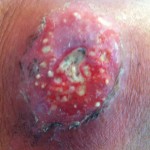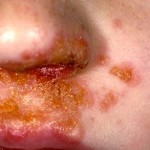
What is MRSA anyway?
MRSA refers to methicillin resistant staphylococcus aureus, which probably means absolutely nothing to most normal people. What we are talking about here are bacteria, a very special type of bacteria.
Staphylococcal Infections
First of, staphylococcus is group of bacteria (commonly known as staph for short) that can cause a wide variety of infections in humans and animals, including food poisoning, boils, abscesses, cellulitis, impetigo, toxic shock syndrome, bacteremia, sepsis, and gastroenteritis.
- Cellulitis
- Carbuncle or Boil
- Impetigo
Notably, staph can live on dry surfaces which makes it a lot easier for them to spread.
Staph Aureus
Staph aureus is one particular type of staph that commonly causes infections. But, it doesn’t always cause trouble and 20-40% of humans carry it as part of their normal skin bacteria.
Infections only occur when Staph invades through broken skin. Infections are also more common in certain groups of people:
- Athletes, especially wrestlers and football players who have close contact leading to cuts and abrasions. Athletes with MRSA very readily spread it to other athletes
- People with eczema or atopic dermatitis who often have breaks in their skin
- Diabetics
- People on dialysis
- Anyone who is immune suppressed
Treatment of Staph Infections
Staph infections are usually not a big problem when caused by normal types of staph. A short course of oral antibiotics does the trick. The problem is that staph has been really good at developing resistance to antibiotics, so there isn’t a lot of normal staph left. Most staph is mutant staph, staph that has developed the ability to survive against antibiotics.
Penicillin killed staph when penicillin was first used in 1943. By 1950, 40% of Staph found in hospitals was resistant to penicillin. So in In 1959 methicillin was developed to treat penicillin-resistant Staph infections (PRSA? I don’t know if that term was ever used). Two years later, Methicillin Resistant Staph Aureus (MRSA) was found in a hospital in England. So there you go, you now know what MRSA is.
Unfortunately, staph didn’t stop mutating in 1952. Its been busy since then.
In 1958, a new antibiotic called Vancomycin was developed that was good at killing Staph, but it could only be given intravenously and early forms of it had a lot of toxicity issues (kidneys). But, since it killed MRSA, it became the standard treatment for MRSA in the hospital despite being a pretty crappy drug to use. Then, in 1996, in a Japanese hospital, someone found VRSA-Vancomycin Resistant Staph Aureus.
Most VRSA can be treated with something called Linezolid. Linezolid was approved for use in 2000.
Linezolid resistant Staph was found in 2001.
You get the point. Its like an arms race. Except that drug trials have now become so expensive to conduct that the pharmaceutical industry has largely abandoned antibiotic research and spends all their time and money looking for the next Viagra.
MRSA moves next door…
MRSA remained mostly a hospital issue. It really only thrived in hospitals and pretty much the only way to get it was to end up in the hospital. There are about 500,000 cases of MRSA in hospitals each year. Out in the rest of the world, regular Staph strains outcompeted it. But in 1981 MRSA was found out in the community and was being spread in people who were never hospitalized. This is called community acquired MRSA and is now quite common. This is the type of MRSA that affects wrestling and football teams.
MRSA in the grocery store…
Yes Virginia, your ham might have MRSA. Scientists tested 295 samples of pork from 36 stores in Iowa, Minnesota, and New Jersey. 65% of them had Staph. They looked at pork that had been raised without antibiotcs and still found Staph on 57% of the samples. 7% of the Staph was MRSA.
So there is MRSA in our meat supply. Which is no surprise, 80% of antibiotics used in the United States are used for pigs, poultry, and cattle. Penicillin and Tetracycline are used in low doses to enhance animal growth (profits). The FDA issued a report in 1977 that this usage was leading to increased resistance in bacteria affecting humans, but nothing has been done about it in the US. In Denmark, which is somehow the world’s largest exporter of pork, this type of antibiotic usage was banned in 1998. The incidence of resistant bacteria in Denmark has been falling. Coincidence?
How to not get MRSA
- Wash your hands with soap and water (antibacterial soap does not work better) or use instant hand sanitizer.
- At the gym: wipe down equipment with sanitizer (usually supplied by the gym) before you use it, or place a towel over benches before you use them. Wash your hands with soap and water. Shower at the gym.
- Shower after sports/activities where you have direct skin contact with people or shared surfaces..
- Keep any wounds clean by washing them daily with mild soap and water and then covering them with vaseline and a bandage.
How to not Spread MRSA if you have it
- Do not share things like razors, towels, wathcloths or uniforms.
- Keep any wounds clean by washing them daily with mild soap and water and then covering them with vaseline and a bandage. The bandages can be discarded in normal trash. Wash your hands after changing your dressing.
- Clean laundry produced by washing with detergent alone will be safe for wear and use-bleaching is not necessary.
The single best source of MRSA is the CDC. They actually have a really good website devoted to the topic.






No Comments
Sorry, the comment form is closed at this time.